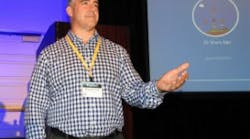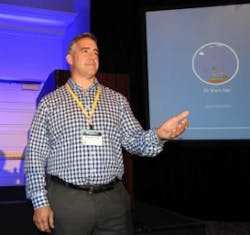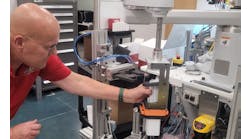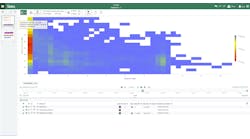“We wanted to be purpose driven, people focused, data informed and technology enabled.” Brooke Cox leads maintenance and reliability enablement projects for Canada’s Suncor Energy.
Ever hear an industrial framework described as “a piece of art”? That’s the term Brooke Cox, who leads maintenance and reliability (M&R) enablement projects for Canada’s Suncor Energy and was speaking on behalf of the FAIM project, uses to describe the deployment of GE Digital’s APM Integrity platform to drive inspection effectiveness and efficiency aligned to the utility’s digital-transformation strategy. APM Integrity is the M&R-focused application within GE Digital’s broader Asset Performance Management (APM) suite.
As part of an initiative they’ve labeled Suncor 4.0 and at the behest of new CEO Mark Little, Suncor teams have piloted a “workplace of the future” and are reaping commensurate competitive advantages. “We wanted to make better, data-driven decisions,” he explained in a presentation at the 2019 GE Digital User Conference in Austin, Texas. “We wanted to be purpose driven, people focused, data informed and technology enabled.”
Adopting the concept of Suncor 4.0 was easy. The real challenge, Cox said, “was determining how to make this all successful.”
Suncor chose an apt partner in GE Digital, which helped define the following project targets:
- A single inspection platform;
- Smooth integration with SAP;
- A common library for failure modes and damage mechanisms;
- Optimized inspection activities for the creation and sustainment of inspection scopes;
- Optimized work management for inspection activities; and,
- Consistent data and formatting to enable enterprise-wide analytics to drive continuous improvement.
Lofty goals. And there were more.
“We want to do more than manage data, we want to get some intelligence from it,” added Vipin Nair, GE Digital product manager, who co-presented with Cox. “How could this application build the solution but also solve current drawbacks?” Nair cited examples such as accurately predicting times for pipe-rotation and extending the life of those assets.
Resistance to standardization
Suncor faced several unique challenges across the enterprise with regards to software and work-process alignment pertaining to mechanical integrity. Complicating matters, there were multiple concurrent mechanical-integrity software applications; some having reached end-of-life and/or showing performance degradation.
Operationally, a lack of standardized enterprise-wide business processes, master-data deficiencies and pipe-rotation requirements for slurry piping needed to be addressed in order to have a one-way approach across the enterprise enabled with an enterprise software platform.
Finally, complicating matters was the fact that most staffers were happy with the status quo, Cox admitted. Suncor was bedeviled by non-standardized processes that nobody seemed eager to clear up. Each business area had its own way of working. Each business area defined how it would meet standards. “We needed to align our digital transformation and drive our learnings across our organization.”
The core of the mission was to prompt more efficiency through APM. FAIM dreamed of a “one-way” inspection-management process that converted the data and workflows from all inspection-management applications into a single mechanical-integrity platform.
The FAIM project people got their wish.
Suncor now has one system, an implementation of GE Digital’s APM Integrity software, into which can flow raw machinery-health data from across the enterprise. They are now performing condition monitoring in real time.
It wasn’t all smooth sailing. One of the greatest challenges was properly shepherding change management. (Sound familiar?) “It’s the people. We developed a new communications plan getting the right people the right information at the right time.” They strategically rolled out training programs to spark enthusiasm and adoption. They marshaled a network of coaches to provide one-on-one guidance. And they produced easily digestible reference guides, housed in the Suncor Knowledge Hub, to enable self-learning.
Cox praised his leadership for their enthusiastic support and stressed the importance of user-acceptance testing, critical in getting the right people on board. A telling sign? Teams that had wanted to participate last during the pilot phase are now requesting to be early adopters of new initiatives.
The engineer beams when he—repeatedly—notes that the project required no customization to the APM Integrity tool. “The beautiful part about having standardized work processes is that we built them into a maintenance and reliability hub…a whole work process laid out in our intranet. It’s a real work of art.”
GE Digital’s participation was critical, added Cox. “Bringing the right people to the team. Building a strong steering committee. Having effective scope management and project management to work our plan. Aligning all of these efforts with our company vision. And executing these projects with sustainment in mind, ensuring that key resources—both internal and external—were clearly vetted and willing to stay committed.”
Suncor has now completed the pilot—gaining leadership and functional support across the business units—and gone live at the first site as of late 2019. They plan to roll out GE Digital APM Integrity across the enterprise by 2021.
“We know that it can be tempting to get complicated with these things, so we made sure to make it simple,” Cox explained. “This is what it does for you. This is how you use it.”
In short, artful execution.





